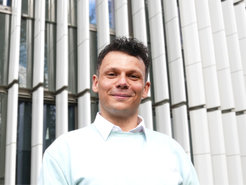Christoph Diehl receives Dissertation Prize for Synthetic Biology
The Max Planck junior scientist is awarded for his achievements regarding the development of artificial metabolic networks
Dr Christoph Diehl from the Max Planck Institute for Terrestrial Microbiology in Marburg is the first winner of the Dissertation Award for Synthetic Biology. The prize was presented during the International Synthetic Biology Workshop on 20 March 2023 in Darmstadt. In the interview, the award winner explains the scope of his research.

The Dissertation Prize for Synthetic Biology was awarded on 20 March 2023 during the International Synthetic Biology Workshop in Darmstadt. It is endowed with 500 EUR prize money, which was donated by Prof. Dr. Hans-Peter Deigner (Furtwangen University).
In his doctoral thesis at the Max Planck Institute for Terrestrial Microbiology, Christoph Diehl researched the optimisation of the CETCH cycle. This artificial metabolic pathway for the efficient binding and conversion of CO2 was developed in the Department of "Biochemistry and Synthetic Metabolism" led by Prof. Tobias Erb. Using the CETCH cycle as an example, Christoph Diehl showed how such networks can be optimised using machine learning approaches, expanded in a modular way and operated flexibly by realising synthetic reaction sequences.
Congratulations, Christoph. What do you consider particularly important in your research topic? Since the CETCH cycle does not exist in nature, it is the perfect blueprint to learn the challenges we have to face when evolving and optimizing pathways. Newly created pathways lead to many questions such as how the different enzymes can be balanced, what happens when combined with natural metabolic networks in vivo or what kind of pathways are compatible with them in vitro.
What fascinates you about synthetic biology? In contrast to existing pathways, which usually exist in a given metabolic environment, new pathways have more space to explore and provide more room to be shaped by the ideas of researchers. There are databases with thousands of different enzymes from all kind of organisms. We as humans can take enzymes from very distinct organisms/habitats and assemble them to create solutions that nature might never have created.
What was the main goal of your dissertation? The main goal was characterizing new-to-nature pathways by optimization. Optimization usually leads to identification of limiting factors and therefore to a better understanding of systems. This is especially important because the ultimate aim for most of the pathways is the implementation in cells (in vivo). Therefore, the fast and in-depth characterization in vitro can help to minimize the workload for later in vivo implementation, which is generally more complex.
A second project was to combine the CETCH cycle with other pathways to produce value-added products like terpenes and polyketides from CO2. My colleague Patrick Gerlinger and I could show that we can produce the backbone of the antibiotic erythromycin from CO2 via a network of 54 enzymatic reactions. For this project, we adapted a mechanism called anaplerosis to replenish CETCH cycle intermediates that are used as substrates for the biosynthesis of our product. Our work demonstrates how new-to-nature anapleurotic modules can be designed and tailored to enhance and expand the capabilities of complex catalytic in vitro reaction networks.
What kind of challenges did you face? For the optimization we had to screen the combinatorial space of the CETCH cycle. Therefore, our goal was to develop a workflow to test hundreds of conditions. To reduce the use of resources, such as purified proteins, we had to downscale the assay volume. Luckily, our group holds two acoustic liquid handlers capable of transferring volumes as low as 2.5 nanoliter.
We used the generated data to train a machine-learning algorithm developed by my colleagues Amir Pandi and Ali Yazdizadeh Kharrazi to iteratively optimize the pathway. Besides, I had terrific support from Nicole Paczia and Peter Claus from the metabolomics facility. We were able to develop a modular optimization workflow, which can be used by other researchers.
What makes the results special and where do you see the potential for application? Regarding the production of value-added compounds, the successful coupling and simultaneous operation of up to 54 reactions provide a first step toward the development of dynamic in vitro catalytic networks. The work demonstrates that anaplerotic reaction sequences provide more flexibility to catalytic networks. But additional layers of regulation will be required to build complex catalytic systems that show the intricate design of natural metabolic networks. New approaches using cell-free transcription-translation systems and recent efforts to couple synthetic metabolism to light-controlled energy modules might provide the requirements to establish such exquisite control in the future, paving the way for further efforts that make use of complex enzymatic cascades in biotechnology.
So by combining our machine learning tool METIS with a liquid handler, we were able to establish a very powerful and universal workflow for optimising metabolic pathways. This opens up the possibility of prototyping new metabolic pathways in the future by measuring only the final product, without the need for intermediate detection to uncover bottlenecks, as is the case with manual optimisation methods. This will help to gain faster insight into new metabolic pathways found in nature and facilitate their transfer into cells.
Thank you, Christoph! I would also like to thank all former and current people from the lab for their support during the last years. Looking at the results it becomes very clear that this was a team effort, that would have been impossible without all the collaborators and help from my colleagues. At the very end I would like to thank Tobias Erb for his support during and after my PhD and highlight the amazing research environment he created to promote creative and independent projects.












